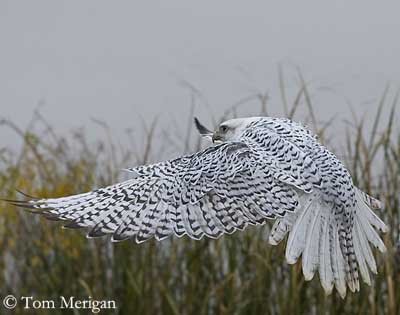
Gyrfalcon
Falco rusticolus
Falconiforme Order – Falconidae Family
BIOMETRICS :
Length: 48-60 cm
Wingspan: 120-135 cm
Weight: M: 960-1320 g – F: 1260-2100 g
DESCRIPTION:
Gyrfalcon is the largest falcon in the world. There are three main morphs, white, grey and blackish-brown or sepia variants.
In the Middle Age, hunting with this wonderful bird of prey was the exclusive privilege of the King.
White morph:
Adult has upperparts, wings, flight feathers and rectrices variably barred or with greyish-black shaft stripes.
Rump and uppertail coverts show narrower bars.
On the wings, primary flight feathers are broadly black-tipped.
On the tail, the median pair shows several narrow black bars. Other rectrices are pure white or slightly marked black.
Fr: Faucon gerfaut
All : Gerfalke
Esp : Halcón Gerifalte
Ital : Girfalco
Nd : Giervalk
Russe : Кречет
Sd: Jaktfalk
Photographers:
Aurélien Audevard
OUESSANT DIGISCOPING
Tom Merigan
Tom Merigan’s Photo Galleries
Text by Nicole Bouglouan
Sources:
HANDBOOK OF THE BIRDS OF THE WORLD Vol 2 by Josep del Hoyo-Andrew Elliot-Jordi Sargatal - Lynx Edicions - ISBN: 8487334156
HAWKS, EAGLES AND FALCONS OF NORTH AMERICA by Paul A. Johnsgard - Smithsonian Institution Press - ISBN: 1560989467
GUIDE DES RAPACES DIURNES – Europe, Afrique du Nord et Moyen-Orient de Benny Génsbol – Delachaux et Niestlé – ISBN : 2603013270

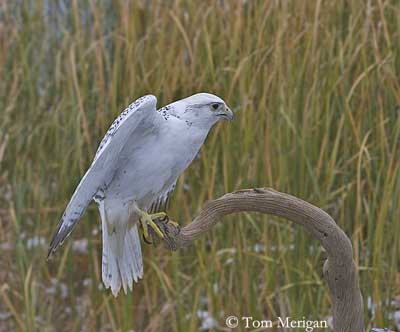
Underparts are pure white with a few small black spots on the breast, belly, sides and flanks.
Head is white with fine black stripes on the rear crown. Bill is pale grey with pale yellow cere. Eyes are dark brown. Legs and feet are pale yellowish-grey.
Dark morph, including grey and blackish-brown or sepia variants:
Entire upperparts are deep grey, sometimes tinged sepia, with dark shafts and bars, and pale narrow feather’s edges. Wings are darker, mainly at tips. Tail is barred with pale bars and tipped white.
Underparts are white with buff or cream-coloured wash, and with dark shafts, including on undertail coverts. On the underwing, wing-coverts are white with dark bars. Chin and upperthroat are usually white.
The head appears as white-streaked. Bill is grey with yellowish cere. Eyes are dark brown. Legs and feet are yellow.
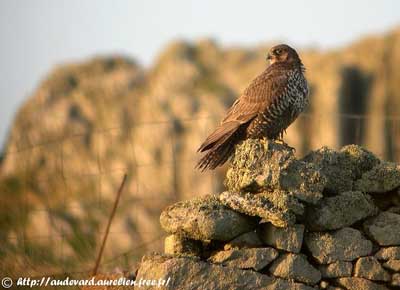
IMMATURE
Dark morph
We can find intermediate morphs, varying between the dark and the white phases. Individuals can be heavily tinged sepia, and constitute the darkest group.
Female is larger and may be darker than male.
In all morphs, juvenile is usually darker and browner, heavily streaked.
Plumage also varies regionally. The birds of High Arctic and Greenland are usually white, whereas in Labrador, they are dark brown to blackish. In Iceland, there are various shades of grey, and across Russia and Siberia, there are about two grey morphs for one white.
The northernmost birds are usually larger in size.
VOICE:
Gyrfalcon is usually silent but near the nest, it gives loud “kiak kiak kiak” and “gik-gik” or “giiiii” when excited.
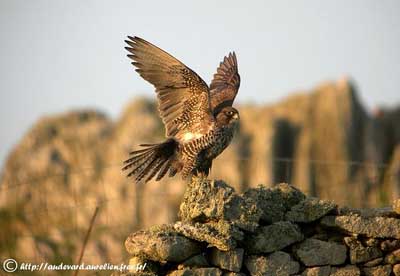
HABITAT:
Gyrfalcon frequents tundra and taiga, up to 1400 metres of elevation, sometimes more.
Its favourite habitats are tundra with streams bordered with cliffs, rocky coats with large seabirds’ colonies, and mountains with rocky outcrops and cliffs.
During winter, the migrants frequent cultivated areas, coasts and steppes.
RANGE:
Gyrfalcon has circumpolar range. It is found in Arctic regions of Eurasia and North America, and in Greenland and Iceland.
Adults are usually sedentary, but juveniles may disperse and move southwards in winter.
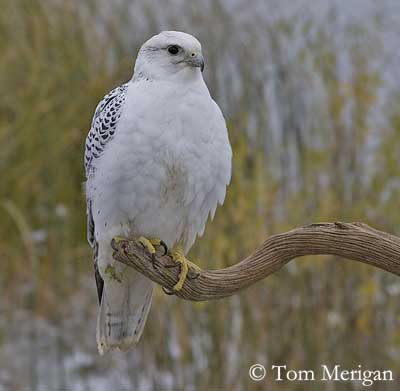
BEHAVIOUR:
Gyrfalcon feeds mainly on birds and mammals such as ptarmigans of genus “Lagopus” and ground squirrels.
According to the range, preys vary from seabirds in coastal areas to lemmings inland.
During winter, the food resources are more restricted for the sedentary birds, whereas the migrants kill large preys such as Greater Sage Grouse.
Gyrfalcon hunts by fast flight low over the ground (between 7 and 20 metres). It catches birds after a brief pursuit or over some distance.
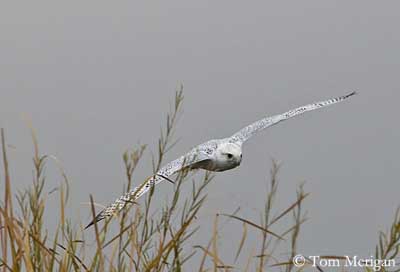
It flies very fast and may rise suddenly to make rapid stoops. It may hover above the vegetation to disturb preys and then, to catch them. It also forages by flying along, or searching preys from a perch.
Preys are more often taken on the ground or water than in the air, but pursuits can be very active sometimes.
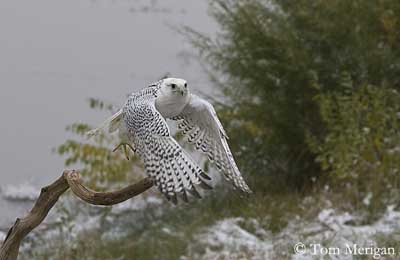
Gyrfalcon performs several courtship displays, including advertising behaviours by males, aerial display by both mates together, displays at nest-site, food-transfer and copulation.
The male performs several flights along the nest-site, parallel to the cliff, or an 8-shaped flight with the crossing point in front of the nest. Displays are accompanied by calls, and male often carries some food-item.
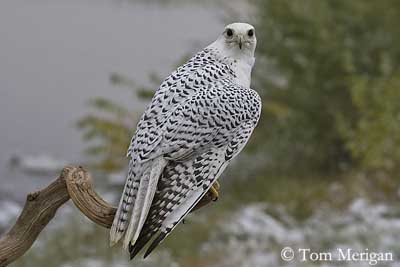
During the displays at nest-site (on cliff ledge), both adults gives rapid series of calls “chup” face one another. Then, the male leaves the site while female remains. Male also performs undulating flight, gliding first and then, rotating its body in opposite directions alternatively. Usually, a dive follows this display.
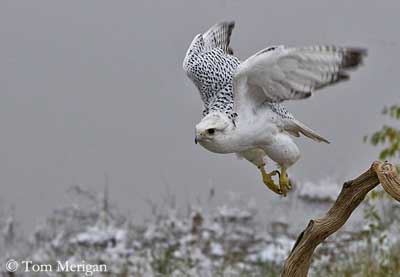
While male is displaying, the female may soar above the nest-site and sometimes both mates perform mutual floating flight with the male flying above the female, and both starting a slow descent in tandem, accompanied by guttural calls by male.
Food-transfer usually occurs on perches, more than in the air.
The display which precedes the copulation is silent. Male adopts a curved-neck posture before to mount the female. She points her bill downwards and her tail is slightly raised. Male is silent, but female utters soft whine.
Territorial defence is usually performed more by male than female. The sedentary male defends the nest-site against the returning migrants.
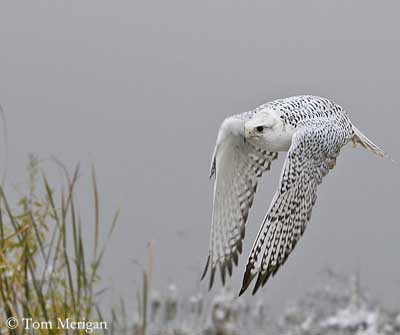
FLIGHT:
Gyrfalcon is very agile in flight, performing several aerial displays and pursuing the preys in rapid flights.
Wing-beats are fairly slow, due to the large size of the bird. It soars and circles with horizontal wings.
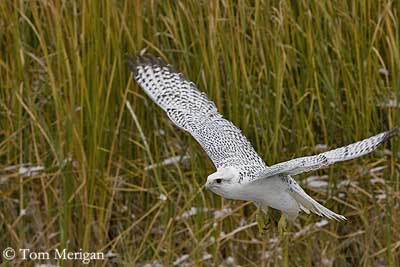
REPRODUCTION:
Breeding season occurs between March and July, but essentially starts in January-February.
Gyrfalcon is solitary nester. The nest is a scrape or a depression in cliff ledge, sometimes in abandoned stick nest, and occasionally on stick nest in tree or artificial structure.
Female lays 3-4 eggs, sometimes more, up to 7 when food resources are abundant. Incubation lasts about 34-36 days mainly by female.
Chicks are covered in white down. They are fed by both parents. The male transfers the food to the female, sometimes far from the nest, more than one kilometre. Female broods them in bad weather conditions.
Youngs fledge about 46-53 days later. They follow the adults during at least one month after fledging. They can breed at 2-3 years.
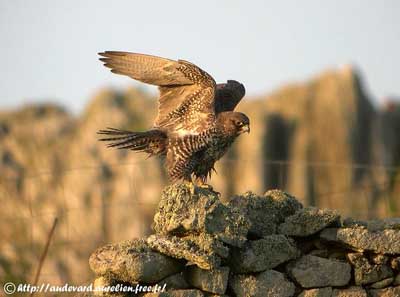
DIET:
Gyrfalcon feeds mainly on birds such as ptarmigans or grouses, which represent about 90% of their diet.
On seacoasts, it catches Laridae and Anatidae, but also ptarmigans.
According to the year, it also takes lemmings and voles in large quantities. It may feed on carrion all year round, in addition to the living preys.
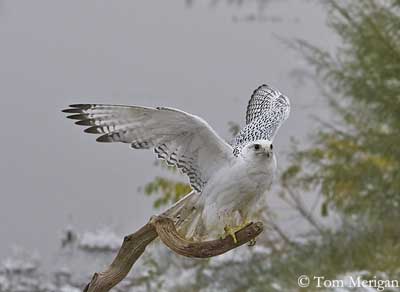
PROTECTION / THREATS / STATUS:
Gyrfalcon is widespread but locally rare or common. This species is highly prized in falconry.
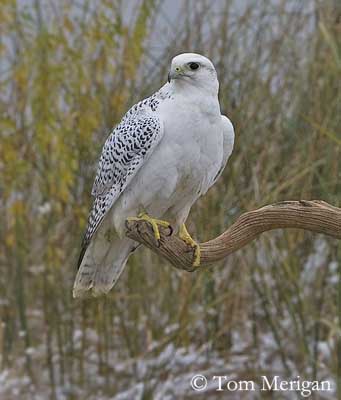
Some declines have been observed, probably due to the numbers taken for falconry, and also to the reduced populations of ptarmigans.
However, populations appear relatively stable, but this raptor is very secretive and difficult to observe.
Gyrfalcon breeds successfully in captivity for falconry and research in several countries of the range.